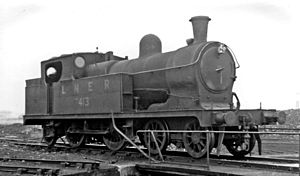GCR Class 9L
| Great Central Railway 9K class London & North Eastern Railway C13 |
|||||||||||||||||||||||||||||||||||||||||||||
|---|---|---|---|---|---|---|---|---|---|---|---|---|---|---|---|---|---|---|---|---|---|---|---|---|---|---|---|---|---|---|---|---|---|---|---|---|---|---|---|---|---|---|---|---|---|

LNER 7413 at Chester Northgate locomotive depot in 1947
|
|||||||||||||||||||||||||||||||||||||||||||||
|
|||||||||||||||||||||||||||||||||||||||||||||
|
|||||||||||||||||||||||||||||||||||||||||||||
|
|||||||||||||||||||||||||||||||||||||||||||||
|
|||||||||||||||||||||||||||||||||||||||||||||
| Type and origin | |
|---|---|
| Power type | Steam |
| Designer | John G. Robinson |
| Build date | 1903–1905 |
| Total produced | 40 (9K / C13) 12 (9L / C14) |
| Specifications | |
|---|---|
| Configuration: |
|
| • Whyte | 4-4-2T |
| • UIC | 2′B1′ n2t, later 2′B1′ h2t |
| Gauge | 4 ft 8 1⁄2 in (1,435 mm) |
| Leading dia. | 3 ft 6 in (1.067 m) |
| Driver dia. | 5 ft 7 in (1.702 m) |
| Trailing dia. | 3 ft 9 in (1.143 m) |
| Wheelbase | 29 ft 10.5 in (9.106 m) |
| Loco weight | 66.65 long tons (67.72 t) |
| Fuel type | Coal |
| Fuel capacity | 3.65 long tons (3.71 t) |
| Water cap | 1,450 imperial gallons (6,600 l; 1,740 US gal) |
| Firebox: • Firegrate area |
19.59 sq ft (1.820 m2) |
| Boiler pressure | 160 psi (1.10 MPa) |
| Heating surface | 1,101 sq ft (102.3 m2) (saturated) |
| • Tubes | 1,778 sq ft (165.2 m2) |
| • Firebox | 108 sq ft (10.0 m2) |
| Cylinders | Two, inside |
| Cylinder size | 18 in × 26 in (457 mm × 660 mm) |
| Valve gear | Stephenson |
| Valve type | Slide valves |
| Performance figures | |
|---|---|
| Tractive effort | 17,100 lbf (76 kN) |
| Career | |
|---|---|
| Operators | |
| Class |
|
| Number in class | 40 |
| Numbers |
|
| Withdrawn | 1952–1960 |
| Disposition | All scrapped |
| Superheated | |||||||||||||||||
|---|---|---|---|---|---|---|---|---|---|---|---|---|---|---|---|---|---|
|
|||||||||||||||||
| Specifications | |
|---|---|
| Firebox: • Firegrate area |
19.59 sq ft (1.820 m2) |
| Boiler pressure | 160 psi (1.10 MPa) |
| Heating surface | 1,031 sq ft (95.8 m2) (superheated) |
| • Tubes | 503 sq ft (46.7 m2) (tubes) 282 sq ft (26.2 m2) (flues) |
| • Firebox | 108 sq ft (10.0 m2) |
| Superheater: |
|
| • Heating area | 138 sq ft (12.8 m2) |
| Great Central Railway 9L class London & North Eastern Railway C14 |
|||||||||||||
|---|---|---|---|---|---|---|---|---|---|---|---|---|---|

LNER 7451 at Ardsley locomotive depot in 1947
|
|||||||||||||
|
|||||||||||||
|
|||||||||||||
| Specifications | |
|---|---|
| Loco weight | 71 long tons (72 t) |
| Fuel capacity | 4.3 long tons (4.4 t) |
| Water cap | 1,825 imperial gallons (8,300 l; 2,192 US gal) |
| Career | |
|---|---|
| Class | GCR: 9L LNER: C14 |
| Number in class | 12 |
| Numbers |
|
| Withdrawn | 1957–1960 |
| Disposition | All scrapped |
The Great Central Railway 9K and 9L classes were two related classes of 4-4-2T Atlantic steam locomotives. They were both intended for suburban passenger services. After the 1923 Grouping, they served the LNER as classes C13 and C14.
Their designer was John G. Robinson. The design was based on the earlier Pollitt Class 9G 2-4-2T locomotives, but with a lengthened boiler and a leading bogie to carry it. This extension of running gear also resembled an early Robinson design for the Irish Waterford, Limerick and Western Railway.
All passed into British Railways service and the first was not withdrawn until 1952. Most were withdrawn between 1955 and 1959. The last examples of each class, 9K 67417 and 9L 67450, were scrapped in 1960. None were preserved.
Forty locomotives were built to the 9K class, in four batches between 1903 and 1905.
The GCR installed water troughs around the same time as this class was built. They were fitted with water scoops, but these were little used by the 1930s and so were removed.
In 1933, six locomotives were fitted for push-pull working, according to the GCR mechanical system. These were converted to the LNER vacuum system and in 1941, two others were converted.
One example, No. 18 was experimentally superheated in 1915. From 1926 to 1935 the entire class was superheated. During this time, the original saturated locomotives were classified as C13/1 and the superheated rebuilds as C13/2. Some locomotives were rebuilt further as C13/3, with shortened chimneys and domes to fit within the LNER loading gauge. By 1938, all locomotives had been rebuilt to the C13/3 standard and so the distinguishing sub-classes were abandoned.
...
Wikipedia
